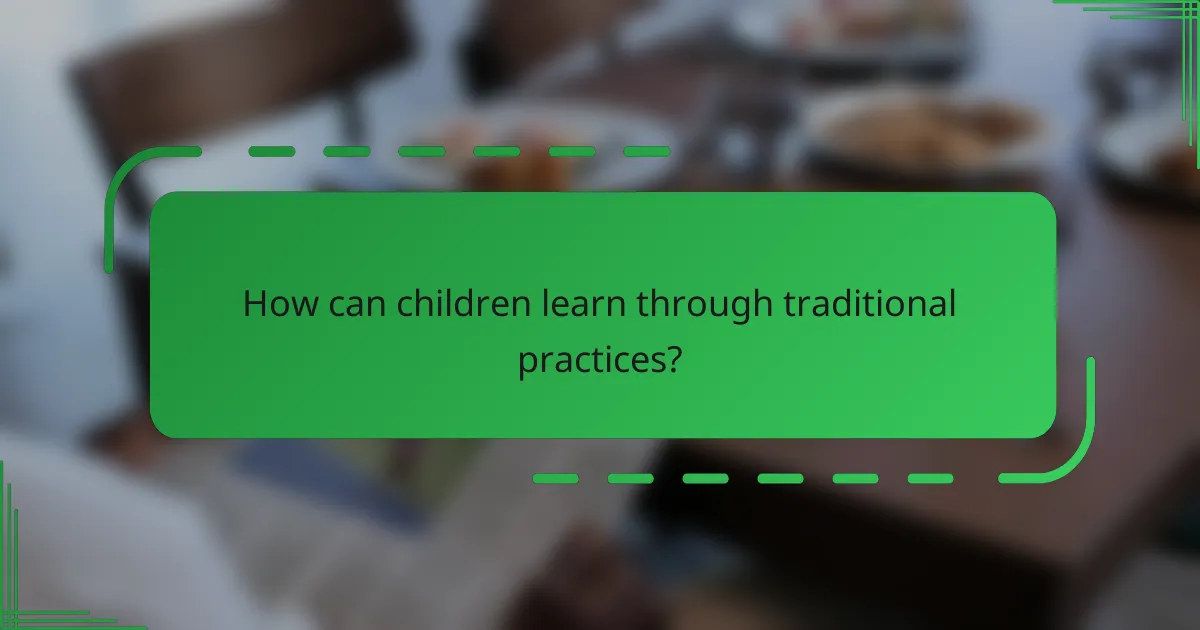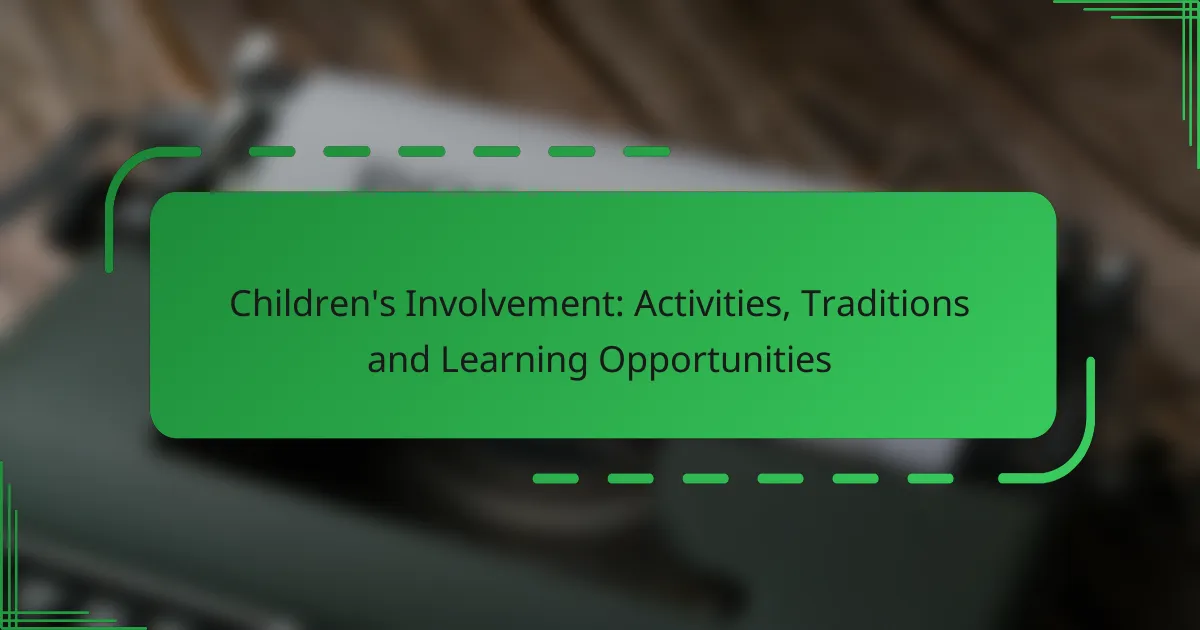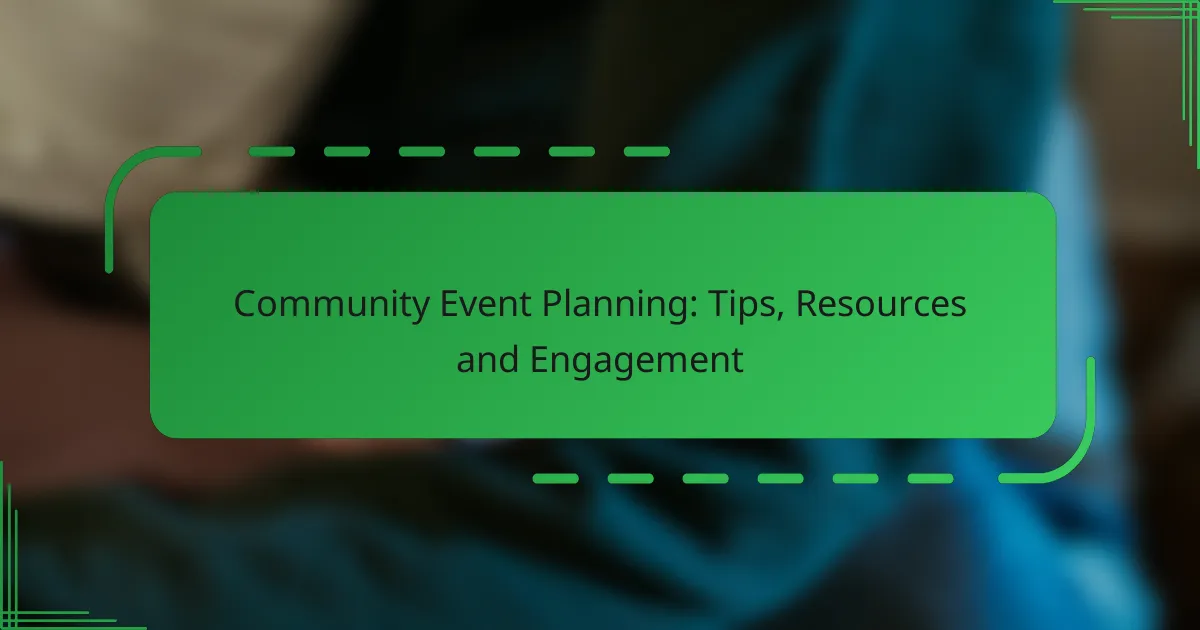Involving children in community activities and traditions is essential for fostering a sense of belonging and cultural appreciation. Through hands-on experiences, such as participating in local festivals and seasonal celebrations, children not only connect with their heritage but also develop creativity and critical thinking skills. These diverse learning opportunities encourage engagement and social interaction, allowing children to explore their interests in dynamic environments.

What activities engage children in community traditions?
Activities that engage children in community traditions often include hands-on experiences that foster a sense of belonging and cultural appreciation. These activities can range from participating in local festivals to joining seasonal celebrations, providing children with opportunities to learn and connect with their community.
Community festivals
Community festivals are vibrant events that celebrate local culture, history, and traditions. Children can participate in various activities such as parades, performances, and craft booths, allowing them to engage with their heritage and meet new friends. These festivals often include interactive workshops where children can learn traditional skills like dancing or cooking.
Parents should consider involving their children in planning or volunteering at these festivals to enhance their experience and understanding of community involvement.
Seasonal celebrations
Seasonal celebrations, such as harvest festivals or winter holiday events, provide children with a chance to experience the changing seasons and associated traditions. These events often include activities like pumpkin carving in the fall or making ornaments during winter festivities. Engaging in these celebrations helps children appreciate nature and the cycles of life.
Encouraging children to participate in local seasonal events can deepen their connection to the community and instill a sense of pride in cultural practices.
Volunteer projects
Volunteer projects are excellent ways for children to contribute to their community while learning valuable life skills. Activities may include community clean-ups, food drives, or assisting at local shelters. These projects teach children the importance of giving back and can foster empathy and teamwork.
Parents should look for age-appropriate volunteer opportunities that allow children to take on responsibilities and see the impact of their efforts.
Local sports events
Local sports events, such as youth leagues or community tournaments, engage children in physical activity while promoting teamwork and sportsmanship. Participating in these events helps children develop social skills and build friendships. Additionally, attending local games can instill a sense of community pride and encourage active lifestyles.
Parents can support their children by attending games together or volunteering as coaches, which enhances the experience and strengthens family bonds.
Art and craft fairs
Art and craft fairs provide children with opportunities to explore their creativity and learn about local artists. These events often feature hands-on workshops where children can create their own art pieces or crafts. Engaging in these activities allows children to express themselves and appreciate the artistic talents within their community.
Encouraging children to showcase their creations at local fairs can boost their confidence and inspire a lifelong interest in the arts.

How can children learn through traditional practices?
Children can learn through traditional practices by engaging in activities that connect them to their cultural heritage. These practices often involve hands-on experiences that foster creativity, critical thinking, and a sense of community.
Cultural storytelling
Cultural storytelling is an engaging way for children to learn about their heritage and values. Through stories passed down generations, children gain insights into their culture’s history, morals, and traditions.
To facilitate storytelling, parents and educators can organize storytelling sessions where children can listen to tales or even share their own. This not only enhances their listening and speaking skills but also encourages imagination and empathy.
Traditional cooking classes
Traditional cooking classes provide children with practical skills while teaching them about their cultural cuisine. By preparing traditional dishes, children learn about the ingredients, techniques, and significance of their food heritage.
These classes can be organized in community centers or schools, allowing children to participate in hands-on cooking experiences. It’s beneficial to include discussions about the cultural importance of each dish, which can deepen their appreciation for their culinary traditions.
Music and dance workshops
Music and dance workshops immerse children in the rhythms and movements of their culture. These activities not only promote physical coordination but also enhance social skills as children learn to collaborate and perform together.
Workshops can include learning traditional instruments or folk dances, often culminating in performances that celebrate their cultural identity. Parents should encourage participation in local festivals where children can showcase their skills and connect with the community.

What are effective learning opportunities for children?
Effective learning opportunities for children encompass a variety of activities that promote engagement, skill development, and social interaction. These experiences can range from structured programs to informal settings, allowing children to explore their interests and learn in dynamic environments.
After-school programs
After-school programs provide children with a structured environment to engage in various activities post-school hours. These programs often include academic support, arts, sports, and social skills development, catering to a wide range of interests.
Parents should consider programs that align with their child’s interests and learning goals. It’s beneficial to look for programs that offer a mix of educational and recreational activities, ensuring a well-rounded experience.
Summer camps
Summer camps offer immersive experiences where children can learn new skills, make friends, and enjoy outdoor activities. Camps can focus on specific themes such as sports, arts, science, or nature, providing tailored learning opportunities.
When selecting a summer camp, consider factors like location, duration, and the types of activities offered. Many camps operate on a weekly basis, allowing families to choose the best fit for their schedules and budgets.
Educational field trips
Educational field trips expose children to real-world learning experiences outside the classroom. These trips can include visits to museums, historical sites, or nature reserves, enhancing classroom lessons with hands-on exploration.
Teachers and parents should plan trips that align with current curriculum topics to maximize learning. It’s essential to prepare children for the trip by discussing what they will see and learn, fostering curiosity and engagement.
Hands-on science projects
Hands-on science projects encourage children to explore scientific concepts through practical application. These projects can range from simple experiments at home to more complex group activities in school settings.
To facilitate effective learning, choose projects that are age-appropriate and align with the child’s interests. Providing materials and guidance while allowing for creativity can lead to deeper understanding and retention of scientific principles.

What criteria should parents consider for children’s activities?
Parents should evaluate children’s activities based on age appropriateness, safety measures, and cost and accessibility. These criteria help ensure that the chosen activities are suitable, secure, and financially feasible for families.
Age appropriateness
Age appropriateness is crucial when selecting activities for children. Activities should match the developmental stage of the child to ensure engagement and safety. For example, toddlers may enjoy simple games and art projects, while older children might benefit from team sports or academic clubs.
Parents can refer to guidelines or recommendations from child development experts to determine suitable activities. Many community centers and schools provide age-specific programs that cater to various interests and skills.
Safety measures
Safety measures are essential to protect children during activities. Parents should assess the environment, equipment, and adult supervision involved. For instance, sports activities should have appropriate safety gear, while arts and crafts should use non-toxic materials.
It’s advisable to check if the activity provider follows local safety regulations and has trained staff. Parents should also discuss emergency procedures with organizers to ensure preparedness in case of accidents.
Cost and accessibility
Cost and accessibility can significantly influence the choice of activities for children. Parents should consider their budget and whether the activity is within reach, both geographically and financially. Many community programs offer low-cost or free options, making them accessible to a wider audience.
When evaluating costs, parents should factor in additional expenses such as equipment, uniforms, or travel. Comparing different programs can help identify the best value while ensuring that children have enriching experiences.



